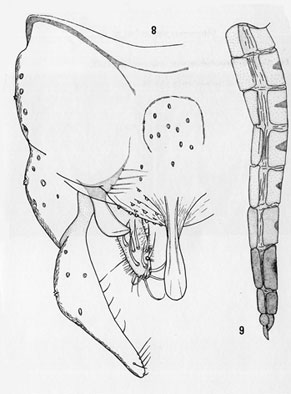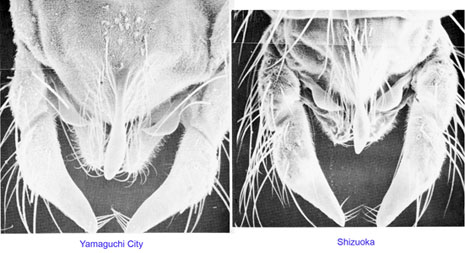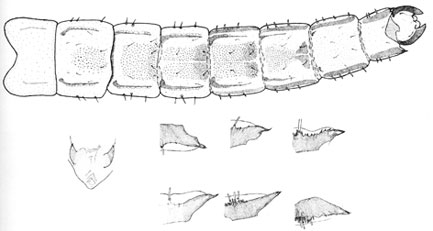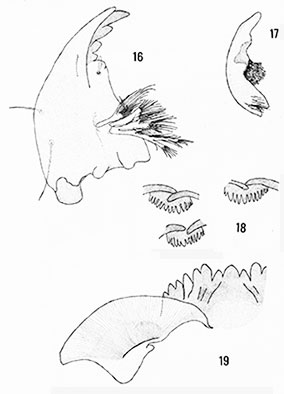Chironomus yoshimatsui Martin & Sublette 1972Synoyms: C. daitoefeus Sasa et Suzuki, 2001 (Yamamoto, unpubl.)
C. echizensis Sasa, 1994 (Yamamoto, unpubl.)In BOLD Bin: BOLD:AAW3949. Adult:
Male
AR 2.85 (2.58 - 3.88) ;Wing length 3.44 (2.97-3.88) mm, VR 1.04 (1.00-1.07); LR 1.65 (1.57-1.85).
Head: Frontal tubercles 25 x 9 µm, palpal proportions (segments 2-5, units) 5 : 30 : 29 : 40. Clypeus as wide as the antennal pedicel, with 19 setae.
Thorax with vittae most of postnotum, and mesosternum yellowish brown, dark central spot on postnotum. Thoracic setae: acrostichal in one staggered row; dorsolateral about 24 in one to three rows;prealar 1; supra-alar 5; scutellar anterior row of 10 smaller setae, posterior row of 13 larger setae (total 23 setae).
Wing with r-m slightly darkened, squama with 17 fringe setae in a partial double row.
Legs yellowish, becoming darker on the tarsi, tarsal joints one to three infuscate with a narrow apical dark band, segments four and five almost completely dark. Foretarsus without a beard.
Leg lenghts (micron) and proportions:
| Fe
| Ti
| Ta1
| Ta2
| Ta3
| Ta4
| Ta5
| LR
| F/T
| Ta5/Ti
| PI
| 880
| 750
| 1200
| 600
| 520
| 450
| 190
| 1.57-1.85
| 1.17
| 0.25
| PII
| 890
| 820
| 490
| 260
| 190
| 170
| 100
| 0.57-0.64
| 1.08
|
| PIII
| 1000
| 1000
| 730
| 400
| 300
| 250
| 100
| 0.63-0.75
| 1.00
|
| 
From Holotype male (Martin & Sublette 1972)Abdominal tergites II-VI with a transversely elongated central spot, that of VII merges into background. SV of type D(d-e) of Strenzke. IV with simple setae.
Yamaguchi City (left); Shizuoka (right).Female (mostly Allotype):
Wing length 4.44 (3.39-4.44) mm, VR 1.09 (1.06-1.09); squama with 38 setae in a partial double row.Antennal proportions: 10 : 30 : 34 : 31 : 44. AR = 0.42; P5/P1 = 4.4. Frontal tubercles 25 x 11 µm, i.e. 2.27 times longer than wide. Clypeus 1.36 times the diameter of the antennal pedicel, with about 40 setae. About 33 postocular setae in 1-3 rows.
Mesonotum with a conspicuous median tubercle. Acrostichal setae in a staggered row; 5 humerals in a sparse clump, 28 dorsocentral (humeral plus dorsocentrals – 33); 5 prealars; 1 supra-alar; scutellum with a slightly staggered posterior row of larger setae and anteriorly with a row of about 16 slightly smaller setae.
Leg lengths (micron) and proportions:
| Fe
| Ti
| Ta1
| Ta2
| Ta3
| Ta4
| Ta5
| LR
| F/T
| Ta4/Ti
| PI
| 1180
| 960
| 1430
| 780
| 680
| 630
| 260
| 1.45-1.50
| 1.23
| 0.66
| PII
| 1240
| 1100
| 600
| 310
| 220
| 150
| 110
| 0.53-0.57
| 1.13
|
| PIII
| 1350
| 1350
| -
| -
| -
| -
| -
| 0.55
| 1.00
|
| Cercus with rounded margin, ventral margin longer and with a prominent basal bulgePupa: Total length females 7.90-9.99 mm; males 7.99-8.66 mm. Coloration generally darkish.
Frontal tubercles small and conical, with a subapical seta.
Base of respiratory organ 0.20 x 0.10 mm; above this base is a elongate, narrow, rugose patch; anterior to the base is a smaller rugose patch. Two Oth setae near the anterior rugose patch, four Mth setae in a longitudinal line parallel to and below the median raphe.
Recurved hooks on tergite II varying in number from 26-117 (mean abt 94). Posterolateral spur of segment VIII usually with a single spine, but varying up to four.
Swim fin with one dorsal and 82 (61- 97) lateral taeniae.  Fourth instar larva: A medium sized (len. 9.8 - 15.3 mm, females (mean 12.68 mm) generally longer than males (mean 11.43 mm) bathophilus-type - however Sasa (1978) notes that one larva had small lateral tubules, so this character may be polymorphic. Ventral tubules relatively short, posterior pair generally longer (Ant.: 0.72 (0.30-1.16) mm; Post.: 0.94 (0.48-1.36) mm.). Anal tubules fingerlike, length about 205-280 µm and 1.8-2.9 times longer than wide; ventral pair sometimes longer than dorsal pair.
Gula and frontoclypeus darkened; frontoclypeus generally darker along the edges and the posterior end.
Mentum (Fig.c) with c2 teeth well separated (type IIA), and 4th laterals not reduced (type 1).
Pecten epipharygis (Fig.a) with about 9-19 usually fine sharp teeth (type A of Proulx et al.) unless worn. Premandible with teeth about equal in length and inner tooth about twice the width of the outer tooth.
Ventromentum (Fig.d) about 3.4 times wider than deep and about the same width as the mentum, with about 44 striae; VMR about 0.28.
Antenna (Fig.b) with A1 about 2.8-3.4 times longer than wide, Ring organ from a quarter to half way up from base of segment; AR 2.33 (2.16-2.46); A2/A1 0.21-0.24; ratio of segment lengths (micron) 104 : 22.5 : 8 : 10 : 6; length of blade about 38-49 µm.
Mandible (Fig.e) length about 205-233 µm, third inner tooth partially separated and coloured (type I-IIB); about 11-14 furrows on outer surface at the base; Pecten mandibularis with about 10-14 setae; MTR about 0.33.
Some larvae showed abnormalities, possibly due to contamination in the habitats.  From Martin & Sublette (1972) From Martin & Sublette (1972)Cytology: Four polytene chromosomes with the pseudothummi-cytocomplex combination AE, BF, CD, G. Nucleolus terminal in arm G, and in groups 18-19 in arm F.
Polymorphic in all arms.
yosA1: 1 - 2c, 10 - 12, 3 - 2d, 9 - 4, 13 - 19 as holomelas A1
yosA2: 1a-k, 2k-d, 9 - 4, 13a-f, 3d-i 12 - 10, 2c-a, 3a-c, 14 - 19 from holomelas A2
yosA3: 1a-k, 11d - 12, 3i-d, 13f-a, 4 - 9, 2d-k, 11c - 10, 2c-a, 3a-c, 14 - 19
yosB1: Puff near center of arm with distal dark bands (groups 8-7)
yosB2: Puff near center of arm with proximal dark bands (groups 7-8)
yosB3: Small inversion of the region of the puff.
yosC1: 1 - 2g, 13e - 11d, 6e-h, 6d - 2h, 11c - 8a, 15 - 13f, 17a - 16a, 7d-a, 17b - 22
yosC2: 1 - 2g, 13e - 11d, 6e-h, 8 - 11c, 2h - 6d, 15 - 13f, 17a - 16a, 7d-a, 17b - 22
yosC3: 1a-e, 5d-6d, 6h-e, 11d-13e, 2g-1f, 5c-2h, 11c-8a, 15-13f, 17a-16a, 7d-a, 17b-22
yosD1: 1 - 6c, 13g-a, 6d - 12, 14 - 24 2 inv from ST
yosD2: 1 - 6c, 13g-a, 6d - 12, 14a-c, 19 – 14d, 20 - 24
yosE1: 1 - 3e, 10b - 3f, 10c - 13
yosE2: 1 - 2, 12c - 10c, 3f - 10b, 3e-a, 12d - 13
yosF1: 1 - 2d, 9 - 2e, 10 - 23
yosF2: 1 - 2d, 16e - 10, 2e - 9, 16f - 23
yosG1: Virtually terminal nucleolus.
yosG2: Simple inversion from yosG1, known only as heterozygote.
yosG3: Complex inversion, known only as heterozygote.
Molecular data
MtCOI: Japanese specimen (AB740260), and Japanese Chironomid Barcode Database.
Sequence in Genbank under the name C. flaviplumus (accession numbers JF412075 - 077). These are very similar to those of C. sp. PK6. Found: Japan - Type locality - Yamaguchi; Hokkaido, JAPAN (Holotype male in U.S. National Museum Collection, No. 71268, March 1970,
H. Yoshimatsu)
Korea - Shilim-dond, Kwanak-gu, Seoul and numerous other localities (as C. flaviplumus, Ree & Kim 1981).
Russia: Sakhalin Island; nr. Vladivostok (Kiknadze et al. 2003). Adults redescribed by Ree & Kim (1981) under the name C. flaviplumus. Karyotype redescribed by Kiknadze et al. (2003). [ Return to Index | Go to References ] |



